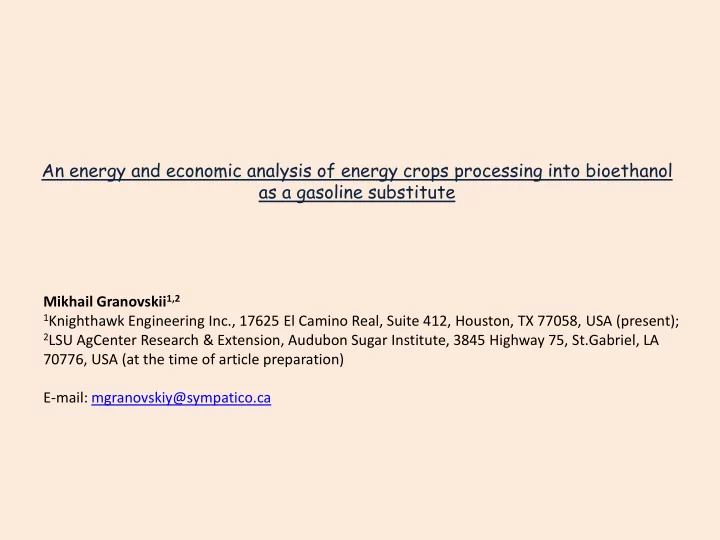

An energy and economic analysis of energy crops processing into bioethanol as a gasoline substitute Mikhail Granovskii 1,2 1 Knighthawk Engineering Inc., 17625 El Camino Real, Suite 412, Houston, TX 77058, USA (present); 2 LSU AgCenter Research & Extension, Audubon Sugar Institute, 3845 Highway 75, St.Gabriel, LA 70776, USA (at the time of article preparation) E-mail: mgranovskiy@sympatico.ca
What is better to grow? Food commodities or energy carriers? $/ Tonne =? $/Tonne= 56 in 2011/2012 in Louisiana Farmers Farmers Cane-like crops Energy cane Sweet sorghum Sugar cane As energy carriers As food commodity Processing Processing Fuel Electricity (Bioethanol) Sugar Market price Market price
General chemistry of commodity sugar and bioethanol production from cane-like crops Stems Cutting and pressing Bagasse Juice Moisture Fiber Solution of sugars in water Cellulose Hemicellulose Lignin Reducing sugars: Sucrose glucose, fructose, etc. Lignocellulosic pretreatment and hydrolysis Separation Fermentation Reducing sugars: glucose, fructose, etc. Fermentation Commodity Ethanol Sugar Ethanol
A conceptual model for renewable electricity and biofuel production from cane-like crops Technology is renewable because the only feedstock is biomass and self-sufficient (sustainable) because all energy demand is met by internally generated bagasse The role of bagasse is twofold: (i) it provides feedstock for lignocellulosic conversion; (ii) it serves as an energy carrier to generate electricity and steam to run the process; During the harvesting season a concentrated solution of sugars (syrup) is manufactured to allow for sugars storage and continuous biofuel (bioethanol) production in a biorefinery Black arrows denote material streams and orange arrows denote energy streams (power and steam)
Energy crops composition and yield Kim, M.; Day, D. Composition of sugar cane, energy cane, and sweet sorghum suitable for ethanol production at Louisiana sugar mills. J Ind. Biotechnol. 2011, 38, 803-807 Component Sweet Sorghum Energy Cane (Dale, M81-E,Theis, and (L79-1001(L)) Topper) Sucrose,% 6.9 7.2 Glucose and fructose, % 4.3 1.1 Total sugars, % 11.2 8.3 Ash 0.96 1.3 Fiber,% 10.6 23.9 Cellulose,% 44.6 43.3 Hemicellulose,% 27.1 23.8 Lignin,% 20.7 21.7 Ash,% 0.4 0.8 Moisture,% 77.2 66.5 Yield, tonne/acre-year 22.1 36.8 Sugars (sweet sorghum) > Sugars (energy cane) Fiber (sweet sorghum) < Fiber (energy cane) Yield (sweet sorghum) < Yield (energy cane)
1G (first generation) biofuel (bioethanol) production directly from sugars in juice vs. Power generation option Bioethanol replaces gasoline proportionally its heating value Juice Instead of bioethanol production bagasse and syrup could be burnt to generate electricity Breakeven prices of electricity for 1G bioethanol production from sweet sorghum and energy cane. Bioethanol replaces gasoline proportionally its heating value. Interpretation At gasoline price 3.5$/gal, if electricity price is 40 Cents per kW-h Electricity 40 cents/kW-h elecricity generation is more 35 Cents per kW-h economically reasonable; at gasoline price 3.5$/gal if electricity price is 25 Cents per kW-h 25 cents/kW-h bioethanol production is more economically reasonable; Bioethanol at gasoline price 3.5$/gal, if electricity price is less than 35 cents/kW-h bioethanol production is more economically reasonable For comparison, in 2009-2011 the average electricity price in US stayed around 9.8-9.9 cents/kW-h and gasoline price was increased from 2.4 to 3.4 $/gallon ( U.S. Energy information administration) .
2G (second generation) biofuel (bioethanol) production from bagasse vs. Power generation option Juice Bagasse Lignocellulosic pretreatment and hydrolysis Breakeven prices of electricity for 2G bioethanol production from sweet sorghum and energy cane. Bioethanol replaces gasoline proportionally its heating value. Interpretation At gasoline price 3$/gal, if electricity price is 13 cents/kW-h electricity generation is more 13 Cents per kW-h economically reasonable; Electricity at gasoline price 3$/gal if electricity price is 7 10 Cents per kW-h cents/kW-h bioethanol production is more economically reasonable; Bioethanol 7 Cents per kW-h at gasoline price 3$/gal, if electricity price is less than 10 cents/kW-h bioethanol production is more economically reasonable An insignificant difference between sweet sorghum and energy cane is due to slightly different composition of their fibers (only cellulose and hemicellulose are converted into sugars) For comparison, in 2009-2011 the average electricity price in US stayed around 9.8-9.9 cents/kW-h and gasoline price was increased from 2.4 to 3.4 $/gallon ( U.S. Energy information administration) .
Sweet sorghum, energy cane, fiber, and reducing sugars prices* for bioethanol production technology at the price of gasoline 3.6 $/gal (average regular pump price in 2012) Crops Crops, $/tonne Fiber, $/tonne Sugars, $/tonne Sweet sorghum 30.0 68 204 Energy cane 33.1 *Those prices include a profit as well as expenses for growing, harvesting transportation and preliminary handling in the front-end plant. The total production (accounting for yields) from the area of 50000 acres and land-use efficiency indicators for two crops and two different scenarios at the price of gasoline 3.6 $/gal Crops Technology Sugars, Gasoline Electricity, Land-use efficiency ** , MMtonne/year equivalent, MW MMgal/year $/acre Sweet 1G+ 0.122 12.3 3.82 N/A sorghum electricity 0.97 * 1G + 2G 0.137 13.8 663 Energy 1G+ 0.152 15.3 39.7 N/A cane electricity 5.78 * 1G + 2G 0.301 30.3 1218 *Generated from lignin separated from reducing sugars **Land-use efficiency indicator includes a profit as well as expenses for growing, transportation and preliminary handling in the front-end plant
CONCLUSION A cultivation of sweet sorghum and energy cane to produce bioethanol as a gasoline replacement at marginal lands, unsuitable for sugar cane , sounds economically feasible at the present price range for fuels and electricity in the U.S. The relative selling price of one tonne of energy cane for bioethanol production is higher than the same of sweet sorghum mostly because of a greater fiber and lower moisture content. Sugars in crops juice have value about three times higher than fiber; therefore, taking into account this proportion, an increase in sugars content at the expense of fiber could be the way to improve quality of energy cane varieties for bioethanol production A greater yield of energy cane allows for increasing land-use efficiency for bioethanol production in about two times.
Recommend
More recommend